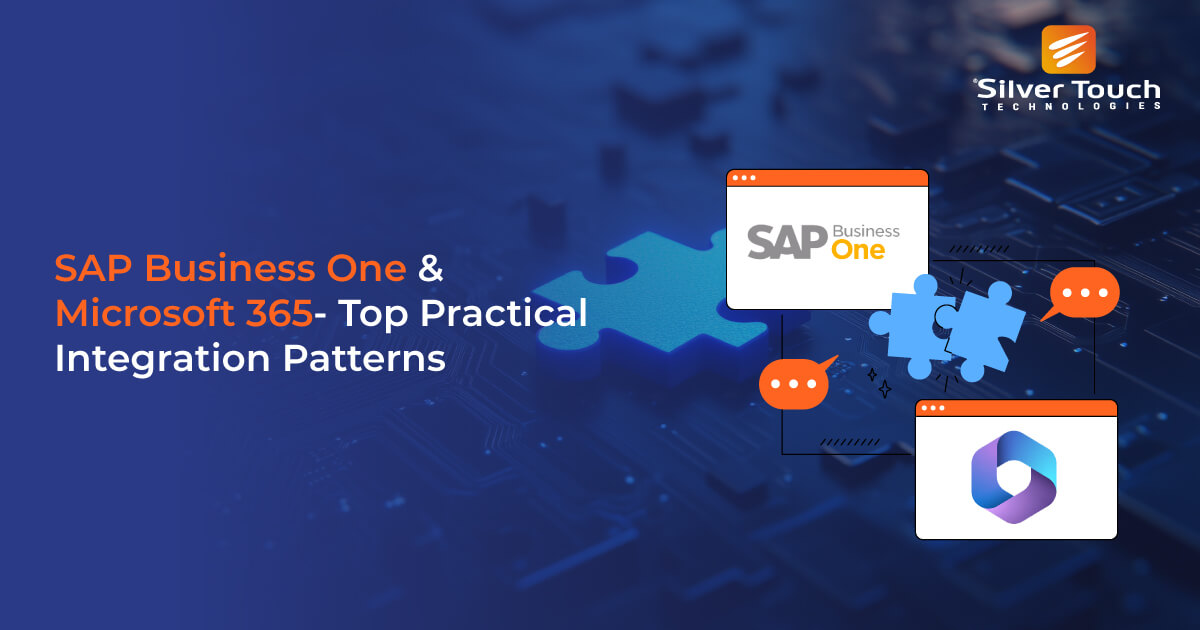Many small and medium-sized businesses (SMBs) must navigate a back-and-forth between SAP Business One and Microsoft 365. This manual juggling of core business data in SAP Business One with the productivity tools in MS 365 is time-consuming and prone to errors. Here, the SAP Business One Microsoft 365 integration comes into play.
This concise guide will show three practical integration patterns for connecting SAP Business One with popular Microsoft 365 apps like Outlook, Teams, and Power BI. It will assist visionary business owners to improve productivity, strengthen decision-making with connected workflows. Let’s begin with the importance of integrating SAP Business One with Microsoft 365.
Why Integrate SAP Business One with Microsoft 365?
Integration of SAP B1 and Microsoft 365 can address several common pain points and deliver significant business benefits. Let’s delve into operational hurdles that this integration can address.
Duplication in Data Entry
As teams copy data from SAP Business One into Excel or Outlook apps frequently, there is a chance of data entry duplication or human errors.
Switching Between Applications
Constant switching between different applications for performing a single task can disrupt the workflow and reduce the overall productivity of your teams.
Slow Data Reporting
Generating detailed reports manually can be slow due to the compulsion to extract data from various sources and collate it in Microsoft tools like Excel.
Connecting two robust business systems, SAP B1 and Microsoft 365, results in a more efficient and collaborative environment. It enables your teams to work together flawlessly. For example, your team can access and share customer information received through SAP Business One within Microsoft Teams. It results in quicker communication on the same platform.
Additionally, this integration can automate workflows to reduce manual effort and save time. For instance, a new sales order in SAP B1 could trigger a notification in Teams automatically. This is also beneficial for meeting the deadlines. Finally, you can get a unified view of business as SAP Business One Power BI integration can give real-time insights through dynamic dashboards.
Top SAP Business One Microsoft 365 Integration Patterns for SMBs
Practical integration patterns of SAP B1 and Microsoft 365 offer useful ways to automate tasks, improve collaboration, enhance visibility, and increase productivity. Let’s dig deep into these patterns.
Outlook & SAP Business One
This pattern connects Microsoft Outlook with SAP Business One data. It enables sales and customer service teams to access and manage crucial data related to customer history, sales activities, and contacts.
The SAP Business One Outlook integration can streamline the communication process, as sales reps can see this information right in their email inbox. This can save time and ensure consistency while managing leads from Outlook directly.
SAP Business One Teams
This pattern brings key processes of SMBs into Microsoft Teams. It is useful for automating critical workflows by sending real-time notifications and approval requests. Whether it is purchase orders or expense claims, managers can easily approve them with a single click through an SAP Business One Teams approval workflow.
Additionally, by using SAP Business One Teams, businesses can eliminate delays and avoid the need for managers to log into a separate system. This makes the approval process quicker and more transparent.
Power BI Dashboards on SAP B1 Data
It is highly beneficial for transforming rich data of SAP B1 into dynamic and interactive dashboards of Power BI. It enables businesses to visualise KPIs (Key Performance Indicators) for every aspect, ranging from finance and sales to inventory and customer services as well. It is also useful to spot trends.
Business leaders can utilise live SAP Business One Power BI dashboards to get a 360-degree view of their company’s health. It increases data visibility for a better decision-making process.
However, these practical patterns bring some challenges for SMBs. Here, we mention common challenges of SAP Business One Microsoft 365 integration and best practices to address them effectively.
Common Challenges & Best Practices
The SAP Business One and Microsoft 365 integration can improve business operations significantly, but it is necessary to overcome some common hurdles. Let’s have a look at these challenges and best practices.
Common Integration ChallengesData Synchronisation Issues
This is one of the main integration challenges. It results in duplicate data or outdated information, leading to confusion and misunderstandings.
Security Concerns
Integrating cloud-based Microsoft 365 into your on-premise or hosted SAP Business One solution can lead to concerns related to data security and privacy.
User Adoption Issues
Your employees may be resistant to changing their existing workflows, and a lack of proper training can lead to a reluctance to embrace a new process.
Best Practices for Effective SAP B1 Microsoft 365 Integration
Use Middleware
Purpose-built connectors or middleware can fix data synchronisation-related issues. These tools can automate the flow of information between SAP Business One and Microsoft 365 and ensure its consistency.
Prioritise Data Safety
It is always essential to choose an integrated solution that follows all the security protocols. Secure APIs, encrypted data transfer, and robust authentication methods can protect your confidential business data.
Give Comprehensive Training
A clear, step-by-step training program and ongoing support can help your employees understand the practicalities of this integration. As a proactive approach, user training can increase the adoption rate.
A reputable SAP Business One partner with a proven track record of successful implementation across different industry sectors can help you overcome these hurdles.
Future Scope of SAP Business One Microsoft 365 Integration
AI-driven reporting, deeper Office integrations, and predictive analytics will be the key drivers of the evolution of SAP B1 Microsoft 365 integration. We can expect more intelligent, proactive, and interconnected systems that will give intelligent insights with recommendations based on the business workflows. This will enable a more proactive decision-making process.
Furthermore, the two platforms will get fused with the help of AI copilots like Copilot of Microsoft and Joule of SAP. This will enable users to get more synchronised and smarter information for their queries in natural language. This will enhance the user experience and make the process more efficient.
Concluding Remarks
SMBs that look to enhance their productivity and gain a competitive edge should opt for integrating SAP Business One and Microsoft 365. Practical patterns for Outlook, Teams, and Power BI with best implementation practices can assist modern businesses in overcoming challenges like data duplication and slow reporting.
Silver Touch Technologies UK is a trusted and Official SAP Business One Partner. We assist SMBs in leveraging the benefits of SAP solutions with advanced tools and technologies. Our in-house team of experienced professionals is ready to help visionary business owners in driving growth using advanced SAP solutions.
FAQs
Integrating SAP Business One with Microsoft 365 enables seamless data sharing, reduces manual data entry, and improves workflow efficiency. It allows teams to work with real-time information, enhances collaboration across departments, and provides better reporting through tools like Power BI for data-driven decision-making.
The most impactful integrations include Outlook, Teams, and Power BI. Outlook allows users to access customer details and sales history directly from emails, Teams supports instant notifications and approval workflows, and Power BI delivers advanced dashboards and analytics by pulling live data from SAP Business One.
Common challenges include ensuring accurate data synchronization, maintaining security when combining cloud and on-premise systems, and managing user adoption. Addressing these issues requires careful planning, secure APIs, and proper training to achieve a smooth integration process.
Businesses should use reliable connectors or middleware for stable data flow, prioritize security with encryption and authentication measures, and provide adequate training to help employees adapt. Regular monitoring and support also help maintain system performance after integration.
Future developments may include AI-driven reporting, predictive analytics, and deeper connections with Microsoft Copilot or SAP’s AI tools. These advancements will make it easier to gain insights, automate tasks, and interact with SAP Business One data using natural language commands.





